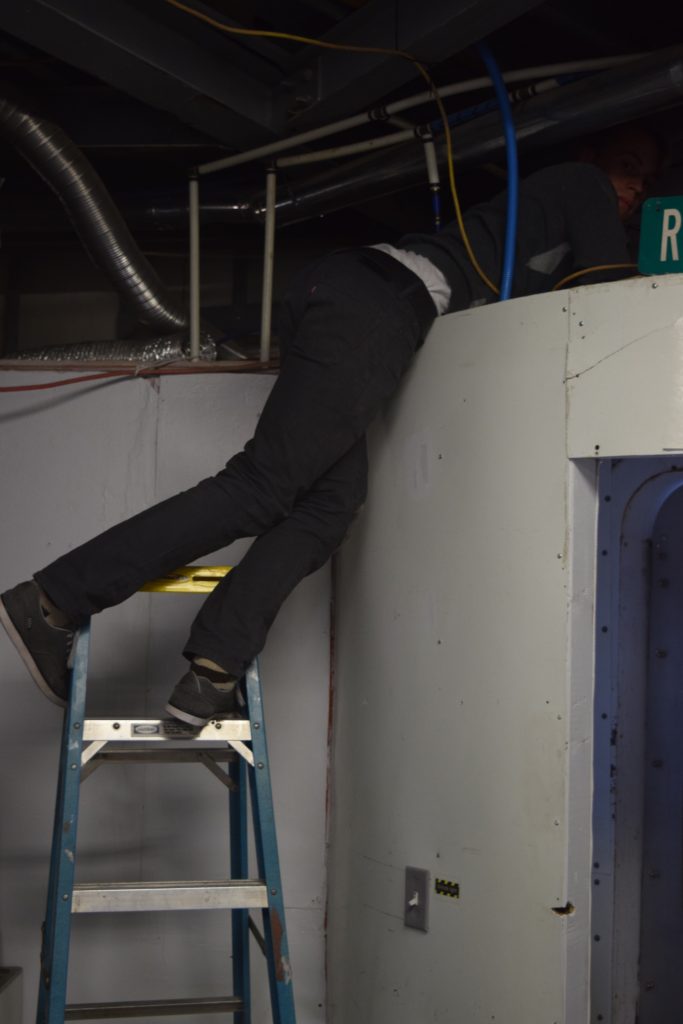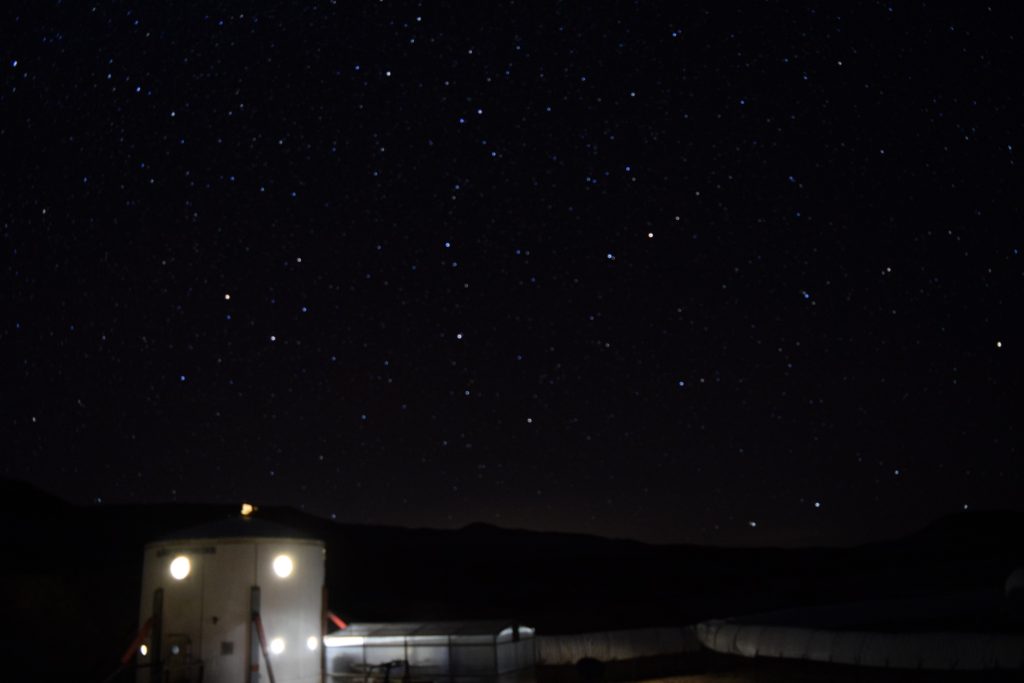SOL: 03
Person filling out Report: Anselm Wiercioch, XO
Summary Title: Longer EVA, beginning greenhab setup
Mission Status: Active. Full crew functional.
Sol Activity Summary: EVA’d to Dinosaur Quarry, set up first conveyor
stage in greenhab, planted first 12 plants.
Look Ahead Plan: EVA tomorrow to follow up on initial Quarry recon
Anomalies in work: back side of helmet cracked slightly on rock.
Repaired with superglue and zip ties. Not majorly concerning, but
helmet henceforth moved to reserve use only.
Weather: High 42F, Low 18F, wind avg 3.5mph, gust N/A, humidity
17-41%, grey cloudy skies
Crew Physical Status: Slightly stir crazy, but ok.
EVA: Anselm, Geoff, and Alison to Dinosaur Quarry
Reports to be filed:
– Sol Summary
– Commander’s Report
– Science Reports
– 6-8 Photos
– EVA Plan
– Operations Report
Support Requested:
– Wifi still intermittent.
GreenHab Report – December 21st
Today began the transplantation of lettuce plants into the Greenhab!
We chose our heartiest crop as the test cultivar for GreenHab
conditions. Temperatures have seemed to normalize but today was
completely cloud-covered and therefore hostile conditions may return
with the sun. We are leveraging differences in soil and hydroponic
systems in order to compare which growing systems may have advantages
in an analog Martian habitat. Conveyor plant stages were setup for Red
Oak Lettuce today. Eight developmental stages will be present by the
end of the mission. Six were carefully separated from the Rockwool in
order to minimize root damage and planted into equal volumes of wet
soil. The hydroponic setup involved creating a hydroponic solution
suitable for the broad range of plant life stages present in the
conveyor experiment. This involved starting with tap water and first
adding a nutrient solution to get the electrical conductivity (EC) to
an appropriate level. This brought the EC to about 1.9 mS/cm. The
next step was to lower the pH to a slightly basic value. After
calibrating the sensor, the pH was reading 6.06 which was well within
the acceptable range. If all goes well, Green Oak Lettuce and other
cultivars will be transplanted tomorrow.
Science Report – December 21st
Geology :
Today on our EVA we observed many interesting rock outcroppings and
geologic formations. It is easy to see the stratified rock layers in
exposed hillsides and cliffs. I moved the main weather station here at
the HAB from the roof to ground level outside the HAB. The reason for
this was that on the roof some of the heat from inside was affecting
the temperature measurements. On the next EVA that I go on I plan to
put another camera in a location of geologic interest (to be
determined) as well as collect the video data from the time-lapse
camera that has been sitting near the Hab for a couple days now. This
camera will have daytime geology data as well as star exposure.
Tomorrow it may snow here so I may give a camera to tomorrow’s EVA
team to set up outside somewhere.
I plan to move the weather station inside the GreenHAB within the next
couple days so that I can gather accurate weather data first. We want
to eventually move it into the GreenHAB in order to use the solar
sensor to measure solar flux in the Green HAB compared to outside.
The last time-lapse camera still sits inside the GreenHAB to monitor
progress there.
Max/Min: Outdoor Temp – 18 F – 42 F
GreenHab Temp – 47 F – 73 F
Barometer – 29.81 – 29.87 inHg
Wind – 3.5 mph, gust – N/A mph
Solar Rad. Max – 201.7 W/m^2
UV Index – 576 uW/cm^2
Outdoor Humidity – 17% – 41%
Crew Photos – December 20th
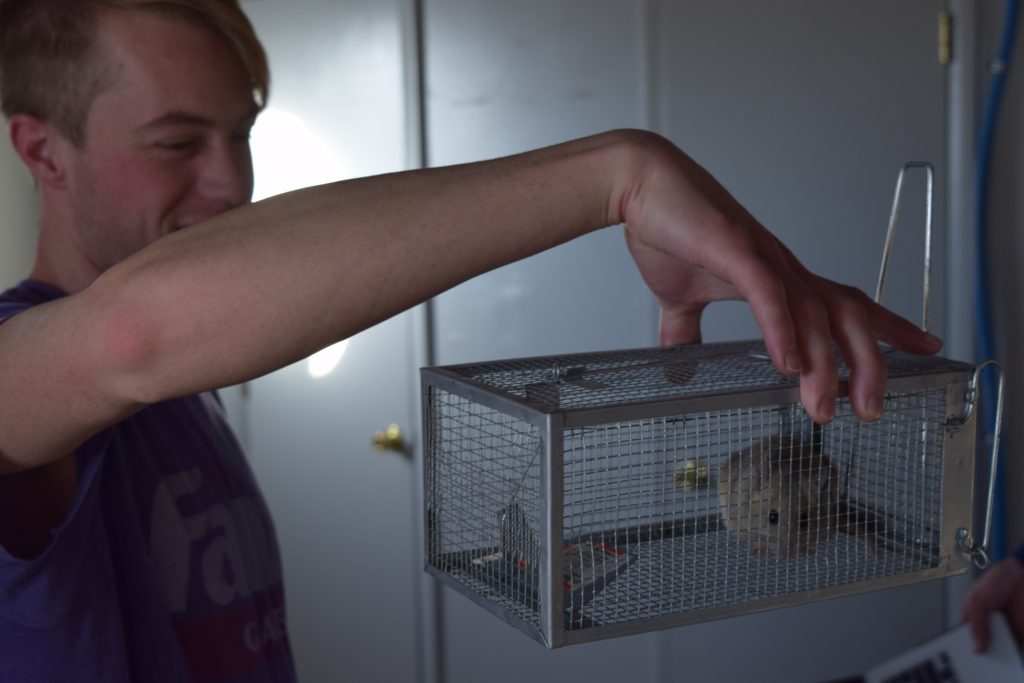

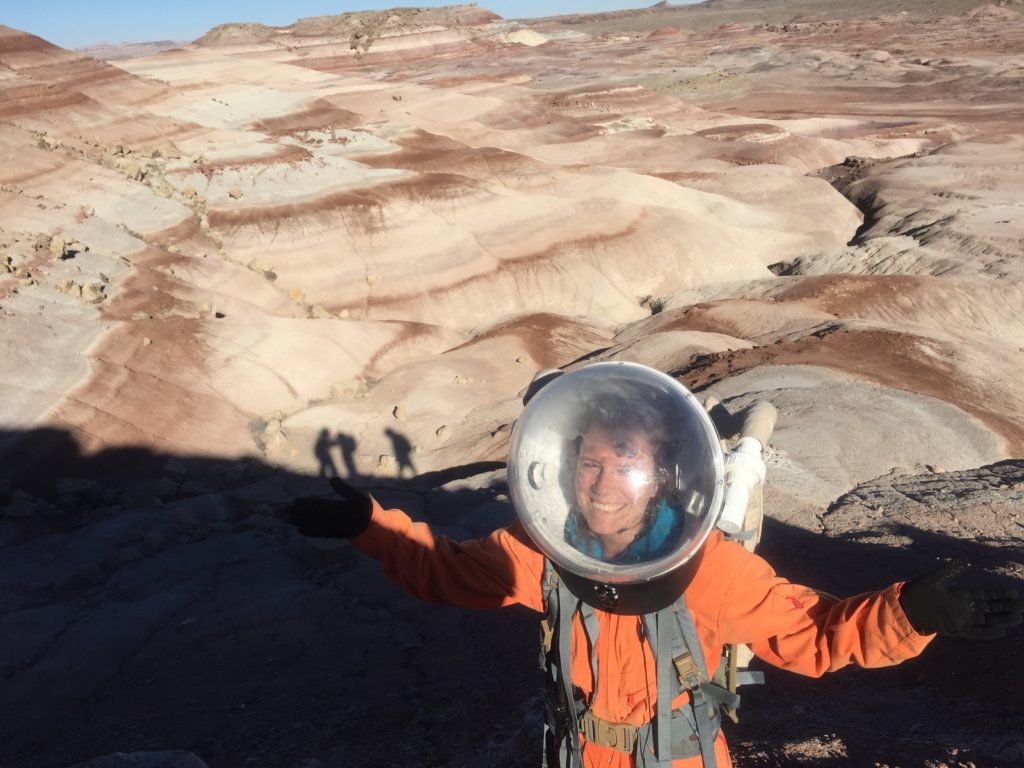
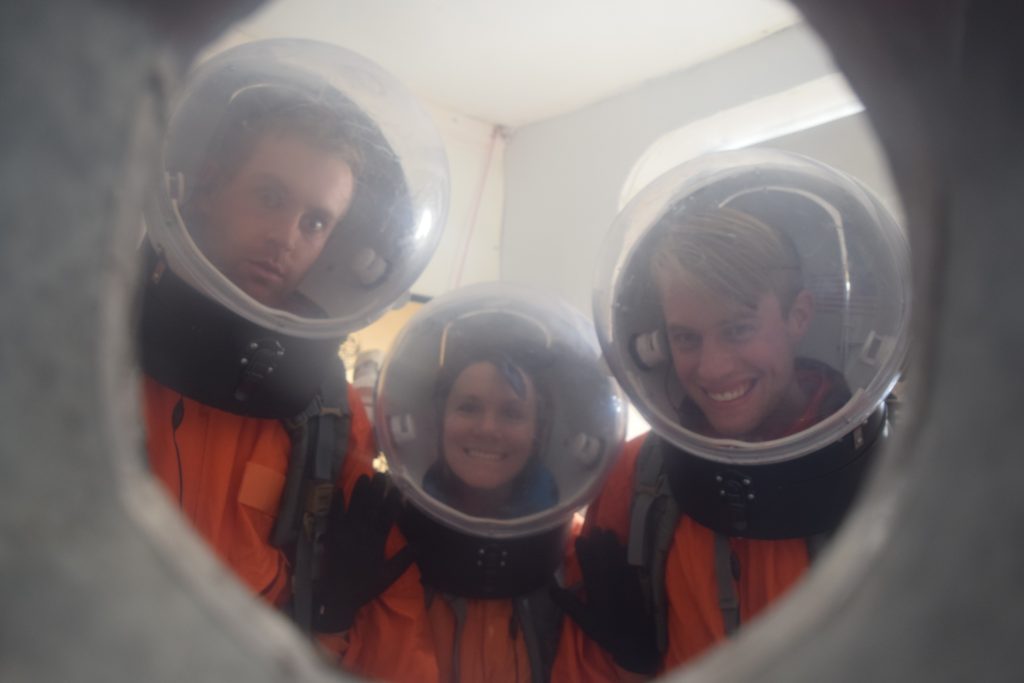

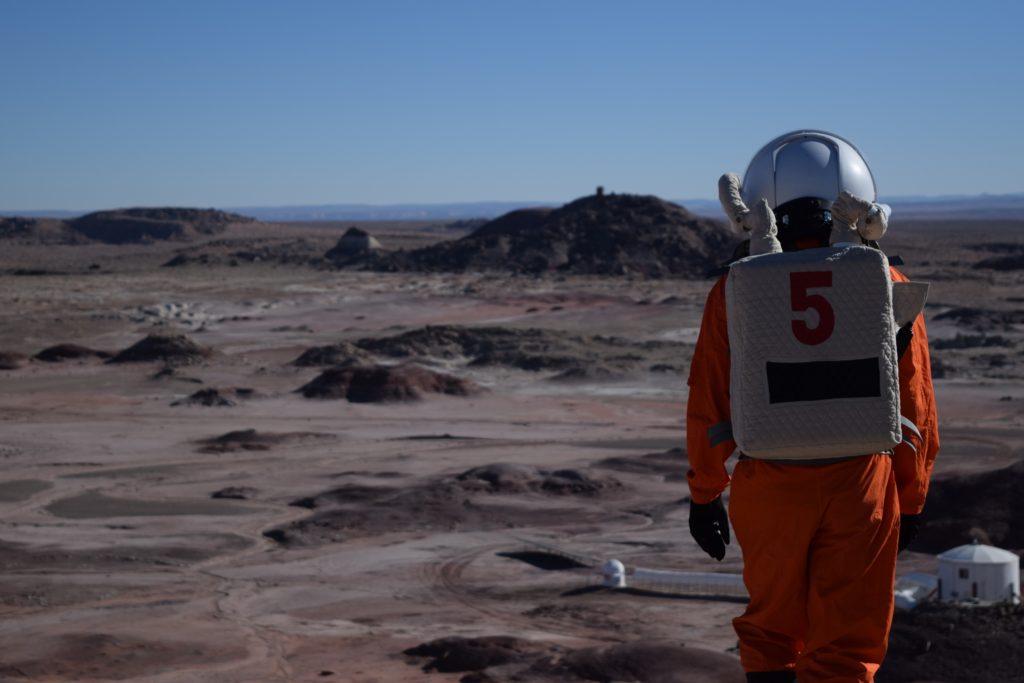


Journalist’s Report – December 20th
Authored by Anselm Wiercioch
We put together a schedule yesterday, but it may take some time to get
on that sleep schedule. We all woke up about an hour late today.
Fortunately, we didn’t have anything super time sensitive on the
agenda so we just shifted everything back an hour. Good to go.
Everyone handled their own breakfast and we had a morning briefing
around 11am. We decided to prioritize an EVA as soon as possible after
landing and ensuring basic resources were available in order to assess
the situation. The hab lands automatically and there haven’t been any
mishaps since the early moon colonization days, but it never hurts to
check. Most of our systems showed nominal by last night, so our
briefing this morning mostly revolved around prepping for that
adventure.
Around 11:45, the first EVA crew was suited up and ready to roll out.
The suits took some adjustment to get everyone fitted, but even at
their best they were heavy and awkward. The suits are thickly
insulated and restrictive (not that I’m complaining, freezing isn’t
fun), and the helmets cut your field of view to about 60 degrees
vertical and 90 horizontal. Functional, but it takes some getting used
to. Our commander has some vibrating-boot-augmented-reali
that’s supposed to identify obstacles so that you can keep your head
up. After wandering around in these suits a bit, I think a system like
that could be pretty handy. Guess we’ll find out later this week. At
noon the three of us (Commander Gibson, Geoffrey, and myself.) entered
the main airlock. The hab crew walked through the depressurization
proceedures while the three of us walked through our own mental
depressurizations. A few seconds later the outer door opened and we
stepped onto the surface of an entirely new planet.
You’re supposed to have some deep, meaningful message to drop at this
point. Something short but poignant. “One small step for man” and all
that jazz.
We were more focused on not dying. The suits (uncomfortable as they
are) are designed to keep us warm and alive and oxygenated, but it’s
one thing to read the spec sheet and another to put your life on the
line testing them in an environment you’ve never seen before. An
environment nobody has ever seen before with their naked eyes. It’s
beautiful. The landscape isn’t much crazier than the Utah desert, but
there’s something immensely humbling about seeing it. It’s hard to
describe. We’re further away from earth than anyone has ever been. And
we’re going for a hike.
We’re not nearly poetic enough for this. What we are though, is alive.
We looked over our own and each other’s suits and we ran all typical
system checks and everything looks good. We sent a plan to CAPCOM that
we’d be circling the hab at a half mile radius, and there’s a hill to
the north that offers a good vantage point, so we head that direction.
Once we reach the top of the hill, the land plateaus for a solid mile
or two before hitting some steeper hills. Looking back, the hab
appears well settled. Nothing unexpected. The landing algortihms did
their job perfectly and everything was in place before we woke up.
Solid.
The landscape is mostly soft dusty hills with clay and rock
interspersed. Rolling hills suround the hab (the site was carefully
selected to avoid dust storms and provide the best landing
opportunities) but off in the distance there are many plateaus and
further away, snow capped mountains. The thin atmosphere makes the
limited color spectrum pop vividly. Rich reds and browns dominate, but
there are streaks of purple and grey and blue interspersed and they
break things up nicely. The sky is gray and dull, but not cloudy.
Just.. flat. It sounds sad, but it’s not. It’s a warm, comforting
gray, and it makes the surface feel even richer.
We take some recon photos to compare to our maps later, and we head
off to the north, following the ridgeline. After another half mile or
so, we run into a dry stream bed that runs back down to the desert
floor. We follow the stream as far as it goes and reach the ground.
Another five or ten minutes wandering yielded a broken chunk of solar
panel and an old, worn battery. Must’ve been from one of the ancient
rovers we sent, back in the day. Comforting to see another thing made
by our species, even if it’s been torn to shreds. Nothing useful
though. We’ve been out for about an hour now, so we head back toward
the hab and open coms for the other crew to prep the airlock for our
arrival.
When we get back, we go through the motions, careful not to track dust
too far from the airlock. We strip our suits and help the second crew
get their packs on. We have water now, and even though mars is chilly,
our suits are warm and our packs are heavy. A shower is definitely on
the agenda. After we get the second group out the door and ensure
their systems are functional, we take turns manning the radio,
showering, and eating lunch. Canned spinach and salmon. Nice.
A nap and some basic reports later, the second crew returns. They
followed much the same path as us, and noted a lot of similar
observations. Double EVA was a success. Ok guys, our work here is
done. Good job. Let’s go home.
Ha.
Not quite. Another day down and 13 to go. Let’s rock and roll.
#FirstContact
Science Report – December 20th
Today’s work (Sol 2) was all about setup and preparation of the
equipment necessary for transplant of cultivars into the GreenHab.
The first task in this process was to review the temperature data from
the night of Sol 1 and determine if turning on the heater had the
desired effect of keeping the climate acceptable for plant growth.
While the hab remained above freezing all night (recorded low of 48 F)
we determined it was likely that the gradient effect was preventing
the warm air from getting down to the level of the temperature sensor.
Therefore, we installed a box fan above the cooler to help increase
the air circulation and hopefully reduce this gradient. We also
experienced a high of 108.7 F at 12:17. We are now manually using
both the heater and cooler for the coming days to try and maintain a
relatively constant temperature moving forward. We are postponing the
move of plant from the hab to the GreenHab until tomorrow to ensure
acceptable temperature variation througout the day. During EVA, we
evaluated the systems that are currently in the GreenHab and prepared
the equipment for the introduction of the plants tomorrow. We also
turned the cooling fan on during the middle of the day again to help
regulate and equalize the temperature. When the first group came back
from their EVA, Curtis & Co. was also at the hab and we were able to
have a very informative discussion with them about the plans for the
aquaponics system. They will be back later in the week with necessary
equipment to help assist with that setup process as necessary. The
last major accomplishment for us was the germination of several
species of seeds that will be moved into the GreenHab tomorrow. These
species included Green Oak Lettuce, Red Oak Lettuce, Radish, Pinto
Bean, Kidney Bean, Popcorn, Carrot, Spinach, Onion and a mystery crop
whose seeds were discovered in the pantry upon our arrival into the
hab. Yay Mystery Crop!
Geology:
Today I installed the weather station on the roof of the HAB with the
help of Crew Engineer Geoffrey Andrews. The weather station on the top
of the HAB will provide a good vantage point so that the solar
radiation sensor will be unobstructed. This data will be used by the
GreenHab scientists in order to quantify solar radiation changes
throughout the day. I plan on moving this weather station to the
GreenHab eventually to compare solar radiation levels.
One of the time-lapse cameras was placed in the GreenHab today to
record the progress in there throughout the duration of the mission.
Tomorrow I plan to install a time-lapse camera on our EVA at our final
destination to monitor the landscape.
Max/Min: Outdoor Temp – 10 F – 51 F
GreenHab Temp – 46 F – 108 F
Wind – 11.9 mph, gust – 12.3 mph
Solar Rad. Max – 592.7 W/m^2
UV Index – 3
Outdoor Humidity – 12% – 45%
Mars Self-Sleep Study:
Anselm, the crew journalist and I Connor have decided to embark on a
change of our sleep patterns in order to gauge the effects and
application to sleep patterns on Mars. We have decided we need more
time for work and a changed sleep pattern may help with this. Most
people sleep by getting 6-8 hours at night and being awake for 16-18
hours during the day. Instead of this pattern, Anselm and I have
decided to reduce our nightly chunk of sleep to 3-4 hours and two one
hour naps during the day. This will increase our overall awake time
during the day to 19 hr. I anticipate being tired the first day but
then adjusting quickly to this pattern.
Hopefully if this works and we become much more productive, we can
recommend these types of patterns for future astronauts. The Martian
day is a little over 24 hours and this has proven to mess up humans’
sleep cycles in certain tests. We want to explore alternative sleep
cycles
11-2 am sleep
(7 hr awake)
9-10 am nap
(6 hr awake)
4-5pm nap
(6 hr awake)
Sol Summary – December 20th
Daily Summary Report
SOL: 02
Person filling out Report: Anselm Wiercioch, XO
Summary Title: First Recon
Mission Status: Crew is alive and well
Sol Activity Summary: Received water refil, went on first EVA
Look Ahead Plan: Planning longer recon EVA tomorrow, considering
sealing water connection further.
Anomalies in work: None significant.
Weather: High 51F, Low 10F, wind avg 11.9mph, gust 12.3mph, humidity
12-45%, clear and sunny skies.
Crew Physical Status: Less nervous, less thirsty. Generally OK.
EVA: Scouted local area around hab. Explored northwestern ridge and
stream to the north of hab.
Reports to be filed:
– Sol Summary
– Journalist/Commander’s Report
– Science Reports
– 6-8 Photos
– EVA Plan
– Operations Report
Support Requested:
– Will be keeping an eye on internet connectivity, but generally OK
for the time being.
Crew Photos – December 19th
Journalist’s Report – December 19th
Journalist’s Log – Sol 01
Waking up from cryo is strange, but after cycling a few hundred times in training, we’re all used to the feeling. Waking up from cryo and seeing the surface of another planet is not something you get used to.
We woke up slowly. All around the same time, but one by one. Not on much of a schedule yet. We’ll put that together after breakfast. Our emails are full of automated messages from CAPCOM. They know we’re “out cold” and aren’t expecting any response. Still, the crew works through their inboxes and we pass along a notification that we’ve successfully arrived and comms are functional.
We spent some time slogging through the ship’s stores (sorry, it’s the “hab” now, isn’t it..) and eventually decided on pancakes. We were supposed to save the mix for a special occasion, but collectively decided that hitting the surface aptly qualifies. Freeze dried blueberries are oddly comforting after almost 300 days of being freeze dried yourself.
At around 11am MST (Mars Standard Time, obviously) a local supply drone arrived with fresh water. Right on time – the ship/hab’s small in-flight tank was close to 6L. Not more than a day or two max with all of us active. The crew got the water system rerouted to pull from the station’s existing tank instead of the hab’s small in-flight tank and we successfully transfered a fresh supply over from the drone. As we would find out later in the day (only after a few showers and meals of course..) the drone malfunctioned and poked a hole in our supply line. Nothing was actively leaking, but next time we transfered water we’d have some issues. A short engineering exploration was conducted and we were able to retrofit the line to bypass the leak. We’re waiting for some adhesive to dry and will be testing the system tomorrow. Fingers crossed. Dehydrating within 3 days would not be a great start for the first people on the red planet.
We were also able to get the hot water heater and the greenhab heater started. After lunch, the hab is already starting to feel like home. I guess that’s a good sign. Going crazy would also not be a great start. The crew is getting along well. Obviously we’ve known each other and trained together for some time. Waking up from hibernation in a strange place that’s inherently running low on standard survival resources will put a strain on any relationship though. Christmas, New Year’s, and a Birthday should help to waylay any concerns there, at least for the meantime.
Anyways, our bandwidth is limted and there’s plenty of work to do still and some non-frozen sleep would be nice. More updates tomorrow. As it stands, we’re alive and warm and nothing is too broken.
#ImNotDeadYet
Science Report – December 19th
SCIENCE REPORT – SOL 1
GreenHab:
A calibrated pH/EC sensor was located in the GreenHab. Last night the temperature in the GreenHab was monitored and dropped to approximately 19F which would be detrimental to plant growth. This prompted us to ensure the heater in the GreenHab was on and functioning. The temperature was set to 75F and will be monitored throughout the night to ensure optimum plant growth conditions. If the temperature stabilizes we will setup the move plant into the GreenHab tomorrow and begin new germination. We also investigated the equipment that is available for use. We have questions regarding the hydroponic systems available. Depending on correspondences about hydroponic capabilities we will alter our research plans and potential growing areas.
Geology:
Today, I installed the indoor temperature sensor inside the GreenHAB so that we can monitor the indoor temperature there. In addition, I prepped my time-lapse cameras for use in the field. I set their exposure time and time between frames. We found the geologic maps of the area here in the GreenHab and are ready for an exploratory EVA to look for interesting sites




